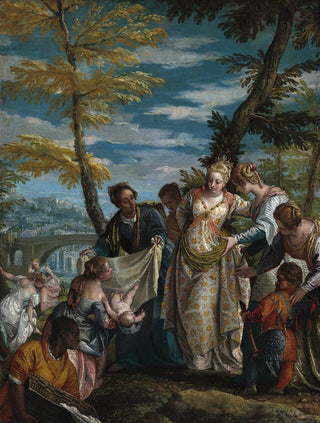Art print | The Discovery of Moses - Paolo Véronèse


View from behind

Frame (optional)
In the fascinating universe of Renaissance art, "The Discovery of Moses" by Paolo Véronèse stands out for its majesty and narrative intensity. This artwork, which immerses the viewer in a pivotal moment of biblical history, is a true ode to light and color. Véronèse, master of chiaroscuro, manages to capture the emotion and grandeur of the scene with a virtuosity that transcends time. The depiction of the discovery of Moses, a foundling child by the daughter of Pharaoh, invites exploration of themes of divine providence and human destiny, while offering an aesthetic that has captivated art lovers for centuries.
Style and uniqueness of the work
The piece is characterized by a dynamic and balanced composition, where human figures are arranged to guide the viewer's eye across the canvas. The sumptuous drapery of the clothing, rendered with remarkable precision, testifies to Véronèse's exceptional craftsmanship. The vibrant colors, ranging from deep blues to dazzling golds, create an atmosphere that is both solemn and joyful. The light, omnipresent, seems to emanate from the characters themselves, illuminating their faces with a softness that contrasts with the drama of the scene. Every detail, from expressions to gestures, is carefully considered to enhance the narrative, making this work a perfect example of art's ability to tell a story.
The artist and his influence
Paolo Véronèse, born in 1528 in Verona, is one of the giants of Venetian painting. His flamboyant style and mastery of colors profoundly influenced his contemporaries and subsequent generations of artists. By integrating elements of classical culture into his works, he created a visual language that combines grandeur and intimacy. Véronèse does not merely depict religious scenes; he transforms them into true spectacles, where each painting becomes a celebration of life and beauty. His ability to incorporate narrative and symbolic elements into elaborate compositions marked a turning point in art history, inspiring artists such as Rubens and Delacroix. His legacy endures.

Matte finish

View from behind

Frame (optional)
In the fascinating universe of Renaissance art, "The Discovery of Moses" by Paolo Véronèse stands out for its majesty and narrative intensity. This artwork, which immerses the viewer in a pivotal moment of biblical history, is a true ode to light and color. Véronèse, master of chiaroscuro, manages to capture the emotion and grandeur of the scene with a virtuosity that transcends time. The depiction of the discovery of Moses, a foundling child by the daughter of Pharaoh, invites exploration of themes of divine providence and human destiny, while offering an aesthetic that has captivated art lovers for centuries.
Style and uniqueness of the work
The piece is characterized by a dynamic and balanced composition, where human figures are arranged to guide the viewer's eye across the canvas. The sumptuous drapery of the clothing, rendered with remarkable precision, testifies to Véronèse's exceptional craftsmanship. The vibrant colors, ranging from deep blues to dazzling golds, create an atmosphere that is both solemn and joyful. The light, omnipresent, seems to emanate from the characters themselves, illuminating their faces with a softness that contrasts with the drama of the scene. Every detail, from expressions to gestures, is carefully considered to enhance the narrative, making this work a perfect example of art's ability to tell a story.
The artist and his influence
Paolo Véronèse, born in 1528 in Verona, is one of the giants of Venetian painting. His flamboyant style and mastery of colors profoundly influenced his contemporaries and subsequent generations of artists. By integrating elements of classical culture into his works, he created a visual language that combines grandeur and intimacy. Véronèse does not merely depict religious scenes; he transforms them into true spectacles, where each painting becomes a celebration of life and beauty. His ability to incorporate narrative and symbolic elements into elaborate compositions marked a turning point in art history, inspiring artists such as Rubens and Delacroix. His legacy endures.






